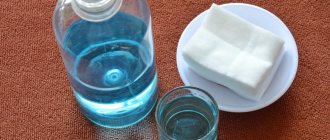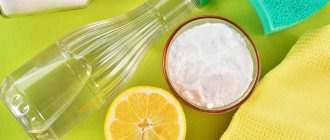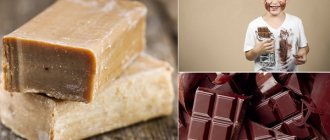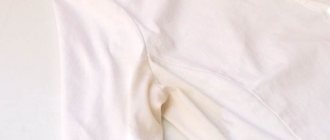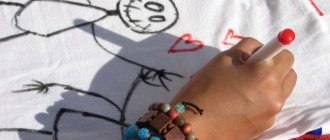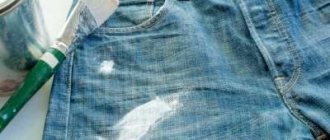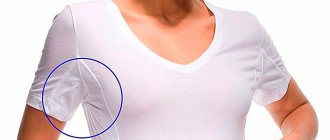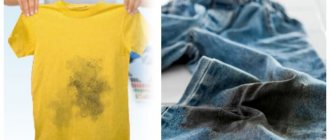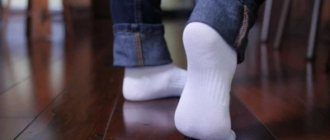Stains on clothes are always unpleasant, especially if the item was beloved or expensive. If ordinary stains that appear over time can be washed off in one go, then having picked up a stain of paint, we become desperate and nothing comes to mind as soon as we throw the thing away or turn it into work clothes.
But before making such a decision, you can try to cope, because how to remove paint from clothes at home has been known for a long time, the main thing is to choose the right method.
Rules for removing paint stains
The axiom of housewives says: the fresher the stain, the easier it will be removed. So what do you need to know to clean your clothes?
- Study the properties of textiles, the type of dye immediately after contamination.
- Not all methods are equally good, some can ruin the thing. Therefore, test your chosen cleaning product on the underside first.
- If the stain remover has warning signs about rapid ignition, a strong smell of gasoline appears, it is better to carry out the manipulation outdoors.
- Cover the surface where the treated item will lie with film.
- To clean, use a cotton swab, this is an excellent option for preventing fabric fibers from shedding.
- Cleaning should occur from the reverse side.
- Constantly change cotton swabs to remove any remaining dye as effectively as possible.
- You can avoid stains on things from removing stains by placing a white napkin under it. The napkin absorbs the remaining liquid.
And two more news, one good, the other not so good: watercolor and gouache can be easily washed off, but oil-based paints will require a lot of effort to remove.
Useful tips
Before you begin cleaning stains left by paint, you need to study the recommendations for a safe and effective procedure:
- Avoid the use of aggressive liquids - gasoline, kerosene, solvents for synthetic fabrics.
- If processing with caustic and hazardous substances is expected, good ventilation should be provided and safety glasses, gloves, and a mask should be used.
- When starting work, be sure to determine what type of contamination has got on clothes or other textile interior items. This will allow you to choose the right product to effectively remove the stain.
- A thick flap is placed under the layer of fabric being treated. If it is a T-shirt or blouse, then separate the back and front halves of the product with a piece of plywood wrapped in a napkin.
- Movements when removing paint are performed towards the middle of the stain.
Shorts in yellow paint
Having completed the cleaning activities, the area of contamination is rinsed, and then the clothes are washed.
Fresh spots
Removing fresh stains is the least evil; the paint has not yet had time to be absorbed into the textile fibers, they have not yet dried and have not changed their structure. What can you use to remove stains? You can display them using the following means.
- Using gasoline when contaminated is a proven cleaning method. To use gasoline, the fabric must be natural. Take clean gasoline that is not used at the gas station. Apply it to the tampon and wipe fresh dirt from the inside out.
- Acetone can be used on colored and white clothes. A solvent is also used instead of acetone. Apply the liquid to a cotton swab and treat the contaminated area.
- Laundry soap is the first assistant for removing fresh stains from water-based paint, watercolors, and gouache.
General recommendations
Gouache and watercolor are not a problem, but what to do with a dried stain of drying oil, water-based emulsion and other complex compositions? Do not try to wash off alkyd paint with water and powder. Always keep solvents like lighter fluid or white spirit in your household. Laundry soap and a number of unexpected folk recipes will help: lemon juice, hairspray and even dish gel.
First steps when a stain appears:
- Blot it with a dry cloth or paper. Let the paint soak in as much as possible.
- Examine the item's label.
- Determine the type of paint.
- Don't put off cleaning until later. If you don’t have time at all, then try to at least soak the stain in a suitable solution.
- If a harsh solvent is required, test it on an inconspicuous area of clothing or on a fabric sample that came with the item. If the fabric is not faded or warped, solvent can be used on the stain.
- Remember to ventilate the area and wear protective gloves when working with aggressive solvents.
Dried spots
Dried dirt is a test for the housewife. To know what we are dealing with, we need to study the labels on the clothing. They indicate information about the quality of the material and its characteristics. Based on this, select a product for removing dried paint.
How to wash, steps:
- Scrape off the top layer of the lesion with a non-sharp object. Scissors or a knife will not work, as you can damage the synthetics.
- Then soften the remaining stain so that the fibers can “give up” the dye particles.
- To soften, use butter, alcohol, glycerin, peroxide, vinegar, and washing powder.
- Then gently clean the stained area. Water-based paints and varnishes can be removed quickly.
How to remove acrylic paint from clothes using solvents
Solvents for acrylic are special products necessary for softening and liquefying acrylic. They can also be used to combat stains.
The action plan includes the following points:
- Prepare the mixture by diluting the solvent in clean (!) water and stirring.
- Apply the solution to the contaminated area.
- Allow the product to absorb and dissolve the paint.
- Rinse the product.
Important! You must first familiarize yourself with the composition of the dyes and solvent in order to choose the right product.
Removing stains of various dyes
Watercolor and gouache can be removed even with water. If they are dry, use the specified softeners, then wash the clothes as usual. How to remove other types of dyes from fabric?
Hair dye
This substance is dangerous for textile fibers, since old stains are practically not removed from it. There are several proven products that help remove hair dye while the stain is fresh.
- Treat with hairspray; the solvent content will help reduce the brightness of the stain.
- If the item is white, soak it in hydrogen peroxide. Leave for approximately 30 minutes. Then wash the item with washing powder.
- Use a vinegar solution.
Acrylic paint
This substance is no less dangerous for matter than the previous one, if it is not washed off immediately. Its structure includes a polymer. After drying, it becomes very hard, eating into fabric fibers. What do you need to remove acrylic paint?
- Blot the stained area with a paper napkin or towel so as not to spread the stain.
- Work from the wrong side of the item.
- Place the area with the stain under running cold water.
- Rub the item well with laundry soap and leave for 2-3 hours. It is better to rub with a brush if this does not damage the fabric fibers.
- After washing by hand, use machine wash with washing powder.
Glass washing liquid, ammonia, acetic acid, and isopropyl alcohol will also help to clean fabric fibers. You can effectively and quickly remove fresh stains with a mixture of: 1 cup of ammonia, 1 cup of acetic acid, a pinch of salt. Use a sponge with this solution to wipe the stained area in different directions. After this, wash the item in the machine.
How to remove oil paint?
Oil-based paints and varnishes are “capricious” substances that are difficult to wash off. Below is a list of products that help remove oil paint from textiles.
- Laundry soap - rub with soap, leave for a couple of hours, wash the item.
- Nail polish remover, refined gasoline, kerosene. Place the fabric on paper towels. Take a cotton swab soaked in liquid and gently work the stain, working from the edges to the center. Then wash with powder.
- A folk remedy is to remove stains from oil-based paints and varnishes with fat. Butter, vegetable oil, and softened pork fat are used. We recommend removing the top layer of dirt with wooden objects to avoid damage to the fabric. Leave the oil for 30 minutes, then put the item in the washing machine for regular washing.
- An effective way is to remove it with a mixture: mix powdered stain remover and butter. Rub the mixture into the dirty area and leave to sit. Grease dissolves colored areas.
Use glycerin on leather and delicate fabrics. It is used cold and heated. At elevated temperatures, glycerin works better.
If these tips don't help, then follow the joke: oil paint stains won't be as noticeable on your clothes if you don't wear them again. This is life and should be embraced with all its surprises.
How to remove stained glass paints?
Stained glass paints are oil-based, making them difficult to remove from fabrics. Be careful when choosing these paints - it is extremely rare to remove them from clothes. It is better to prevent contamination than to regret a damaged item later.
You can remove minor fresh stains with acetic acid by soaking the fabric in 70% acetic acid. Be sure to wear gloves when working with such solutions.
Removing stamp stains
It is extremely difficult to remove stamp ink from clothes; it eats into not only the fabric, but even the skin of your hands. If this substance gets on your trousers or dress, it is better not to wait, but to go to the dry cleaner. If it is not possible to give them to specialists, use the following means:
- Cool boiling water. Try not to get burned.
- Wet wipes containing alcohol.
- Hair fixation spray.
- Cologne, unnecessary eau de toilette. Rub the soaked piece of cloth, then place it in the washing machine. This method is a quick and effective method for removing such paints.
Ammonia and turpentine showed excellent cleaning results. Their mixture is poured onto the dirty area.
Removing finger paint marks
Finger paints are a difficult stain on clothes. When working with these substances, you should wear household items, an apron and arm sleeves. The recipe for using Antilyapin laundry soap has been tested. This is an excellent remedy in this situation.
How to remove ink from a printer?
Don't waste a minute when removing contamination! Start washing immediately. Remove clothing and place it under very cold water. Wash the required area of the fabric with laundry soap. Before soap, you can use ammonia by rubbing the stained area with a cotton swab.
Lemon juice effectively and quickly removes printer blots on clothes. Pour in the juice, sprinkle salt on the dirty area, and set aside for 3-4 hours. Then load it into the washing machine.
If liquid from a toner cartridge has just spilled onto a cloth, ordinary milk will help to quickly remove it. Clothes are soaked in it for at least 12 hours. This method helps to completely bleach the fabric.
Video instruction
If you want to see how the procedure is performed, watch the video:
We remove marks from light-colored items: shirts, blouses, T-shirts
Boiling is a great way to remove paint stains from white items. To do this, add to 1 liter of water:
- laundry soap shavings;
- a cap of ammonia;
- 1 tbsp. a spoonful of soda ash;
- cap of hydrogen peroxide.
The container with the resulting solution is placed on gas. The clothes are soaked and boiled for 40 minutes over low heat. After the water has cooled, the items are removed for washing or rinsing with conditioner.
Boiling is contraindicated for blouses made of delicate and thin fabrics. It is better to use industrial stain removers for them. Special products not only get rid of local dirt, but also help keep things white.
conclusions
Housewives, we all want to look impeccable, clean and tidy. If blots from paint and varnish substances appear, do not panic, but remember simple truths:
- Find out what kind of substance left a trace on the clothes.
- Remember the axiom of housewives written above, and run urgently to save your favorite thing.
- If you still didn’t manage to save the blots before they dried, use our tips to restore cleanliness and neatness.
Have you tried many methods, but the mark is still visible? Don’t despair, but think about the fact that the main things in life are not things after all!
See you soon!
How to properly wash children's clothes
As I already wrote above, children's clothes are much more delicate in fabric than adults. In addition, babies' skin is much more sensitive to the clothes they wear.
Therefore, washing children's clothes requires careful and careful care. To wash children's clothes and remove watercolor paints from them, choose the following products:
- choose baby powders, for example, “Eared Nanny”, “Stork”.
- Laundry soap will help out in almost any situation. Rub it onto the stain on children's clothing, let it soak in a little and wash the item. There will be no traces left of the watercolor!
- If you don't have laundry soap, you can use simple baby soap. As a rule, it contains hypoallergenic substances that are safe for children’s skin, and therefore their clothes.
- Bleach and products with complex chemical compositions should not be used.
Food coloring
At home, you can get contaminants from food dyes in the kitchen if you want to decorate confectionery or color eggs.
Rich yellow, blue, and red paint ends up on tablecloths, tulle, towels, tablecloths, and clothes. It is recommended to clean them immediately.
Pour 200 ml cold water into an enamel bowl. Add ammonia - 1 tsp. This solution removes any dirt that appears.
There are many ways to deal with marks from various types of paint. It is important to choose them wisely so as not to harm the textiles. In difficult cases, it is advisable to contact a dry cleaner.


